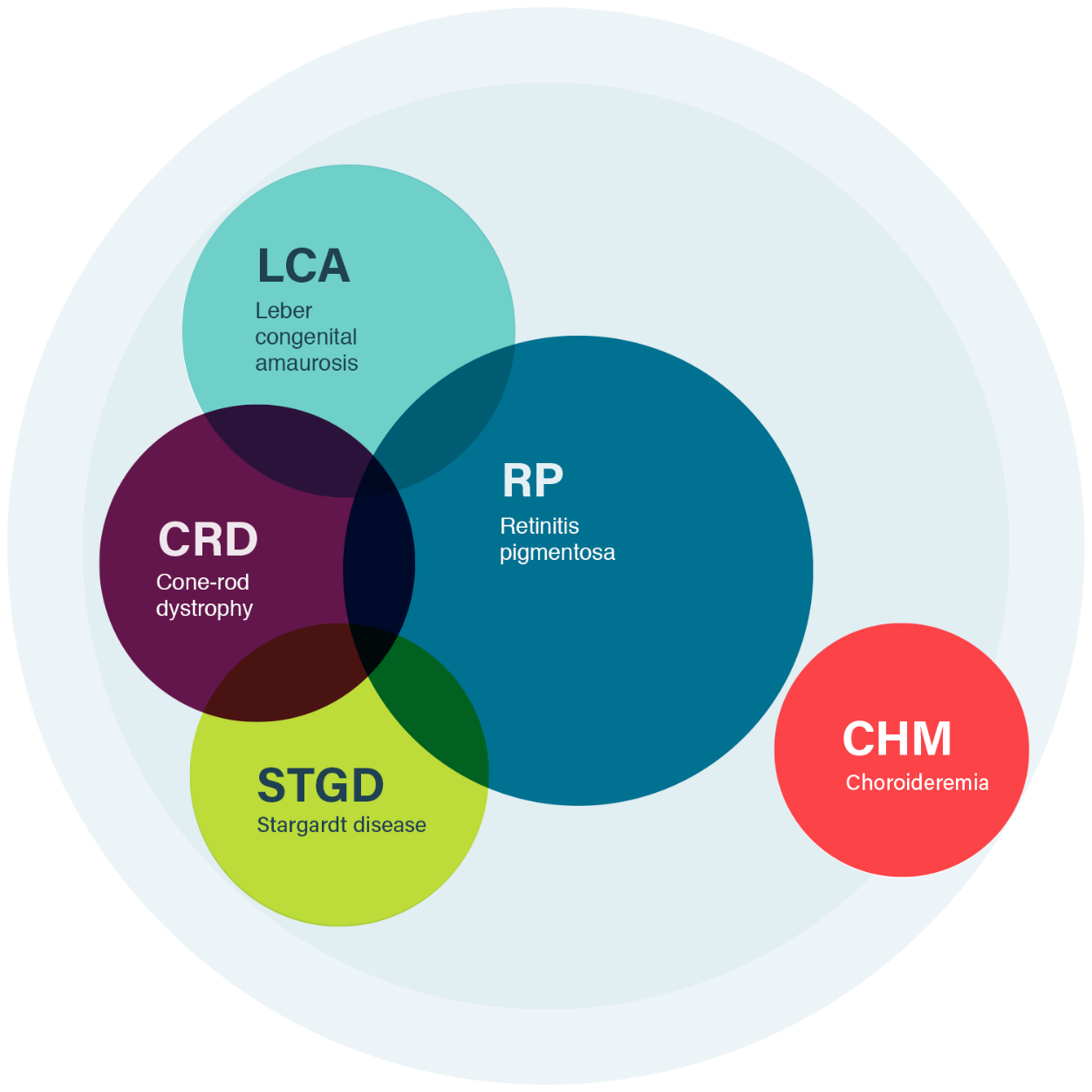Understanding inherited retinal diseases (IRDs)
What are IRDs?
Inherited retinal diseases (also called inherited retinal dystrophies, or IRDs) are a group of rare eye disorders caused by inherited gene mutations and can result in vision loss or complete blindness.
Highlights:
- IRDs are caused by inherited gene mutations.
- Vision loss patterns vary from person to person.
- Age-related macular degeneration is not considered an IRD.

A constellation of IRDs
Some people with an IRD, for instance those with retinitis pigmentosa (RP) or choroideremia (CHM), experience a gradual loss of vision, eventually leading to complete blindness. Others, with conditions such as Leber congenital amaurosis (LCA), may be born with or experience vision loss in infancy or early childhood.
Common IRDs
Retinitis pigmentosa
These inherited, progressive eye diseases appear when the light-sensing cells of the retina—the rod and the cone photoreceptors—begin to deteriorate. Night blindness (nyctalopia) in childhood or early adulthood is typically the first symptom. As the disease progresses, those with RP experience loss in their peripheral (or side) vision, developing tunnel vision. Eventually, they lose their central vision as well, resulting in total blindness.
Need a refresher on rods and cones? Want to learn more about the parts of the eye (eye anatomy)? You can find a glossary of terms, as well as additional information, on our Community Stories and Resources page. Check it out.

Leber congenital amaurosis
Appearing in infancy or early childhood, LCA can result from mutations in numerous genes and causes severe visual impairment in infants, leading to eventual childhood blindness. Babies frequently have “wiggly eyes” (nystagmus, or involuntary back-and-forth eye movement), signs of night blindness (nyctalopia), increased light sensitivity, and a tendency to rub, press, or poke their eyes with their fingers.
Need a refresher on rods and cones? Want to learn more about the parts of the eye (eye anatomy)? You can find a glossary of terms, as well as additional information, on our Community Stories and Resources page. Check it out.

Cone-rod dystrophy
Cone-rod dystrophy begins in childhood and differs from other IRDs by the order in which parts of the eye experience deterioration—cone photoreceptors first, followed by rod photoreceptors. This leads to an associated switch in the onset of symptoms. Patients initially lose color vision and central vision, followed by a progressive loss of peripheral (or side) vision.
Need a refresher on rods and cones? Want to learn more about the parts of the eye (eye anatomy)? You can find a glossary of terms, as well as additional information, on our Community Stories and Resources page. Check it out.

Stargardt disease
Stargardt disease, or Stargardt macular dystrophy, is the most common type of juvenile macular degeneration. Stargardt disease, which typically develops in childhood or early adulthood, occurs due to degeneration of the macula, a part of the eye responsible for central vision. That is why people with Stargardt disease usually experience a progressive loss of central vision. They may also have difficulties with night vision and sometimes color vision.
Need a refresher on rods and cones? Want to learn more about the parts of the eye (eye anatomy)? You can find a glossary of terms, as well as additional information, on our Community Stories and Resources page. Check it out.

Choroideremia
This X-linked disease begins in childhood and is caused by the degeneration of the choroid and retinal cells. Night blindness (nyctalopia) tends to be the first symptom, followed by tunnel vision and, later, central vision loss. The vast majority of patients with CHM are male, though a small minority of females may also suffer from disease symptoms.
Need a refresher on rods and cones? Want to learn more about the parts of the eye (eye anatomy)? You can find a glossary of terms, as well as additional information, on our Community Stories and Resources page. Check it out.

Need a refresher on rods and cones? Want to learn more about the parts of the eye (eye anatomy)? You can find a glossary of terms, as well as additional information, on our Community Stories and Resources page. Check it out.
Is age-related macular degeneration an IRD?
Age-related macular degeneration (AMD or ARMD) is not caused by a mutation in a single gene, but may occur due to genetics, environmental factors, or lifestyle choices (such as smoking). There are a number of good resources for anyone living with AMD/ARMD, including the websites for the Foundation Fighting Blindness (FFB) and the American Macular Degeneration Foundation
.

COMMUNITY INSIGHTS
Overall, I live a very healthy, fulfilled life. Yes, I’m being robbed of my eyesight, but I’m not being robbed of living.”
FICTION!
There are several options available for management of IRDs. Once you receive a definitive diagnosis of an IRD, which may be achieved through genetic testing, your ophthalmologist or other HCP may recommend visual aids and lifestyle changes that may help you manage your disease. In addition, you may be eligible to participate in a clinical trial involving your specific IRD. Be sure to take advantage of the strong IRD community for support, advice, and ideas for living with an IRD.
